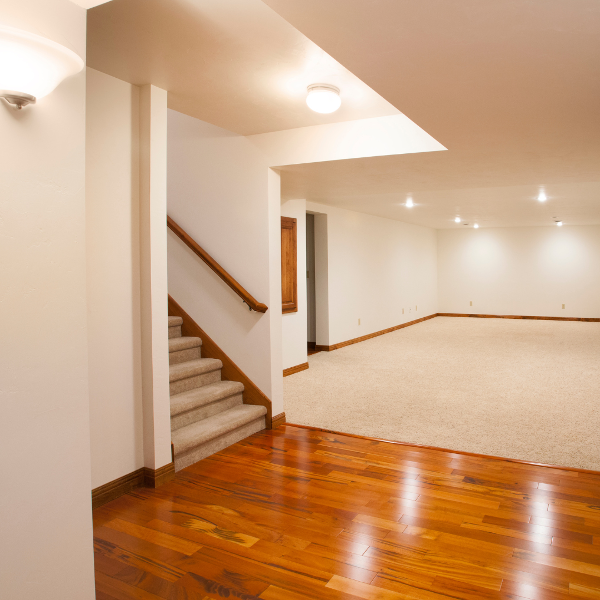Blog > How to successfully intertwine different flooring types throughout your home
How to successfully intertwine different flooring types throughout your home
Tuesday, January 7, 2025

When it comes to designing your home, flooring plays a significant role in setting the tone, style, and functionality of each room. Traditionally, many homes have adhered to a single flooring style throughout, but recently, more homeowners have embraced the idea of combining different types of flooring within one space. Whether you're transitioning from room to room or highlighting different zones within an open-concept area, mixing and matching flooring can add depth, style, and a unique flair to your home. Below, we’ll dive into how to successfully intertwine different flooring styles and explore the many advantages of this approach.
1. Identify the Purpose of Each Area
Before diving into which flooring options to combine, it’s essential to consider the functionality of each space. Certain flooring materials are better suited to specific areas in your home based on factors like traffic, moisture, and durability.
- High-Traffic Areas: For living rooms, hallways, or kitchens, opt for durable materials like hardwood, vinyl, or tile.
- Moisture-Prone Areas: Bathrooms or laundry rooms benefit from tile or waterproof laminate flooring, as these materials withstand humidity and water exposure.
- Cozy Zones: Bedrooms and lounges might welcome the warmth and softness of carpet or engineered wood flooring to add comfort.
When combining different floors, the first step is understanding the needs of each room and using flooring materials that are not only visually pleasing but also practical.
2. Use Transitions and Thresholds Wisely
Seamless transitions are crucial when blending flooring in different rooms. The way you move from one flooring type to another can make or break the aesthetic flow of your space. Here are some ways to manage this:
- Threshold Strips: Transition strips or thresholds are a simple and stylish way to separate two flooring types. They come in various materials, including wood, metal, and rubber, and can provide a clean line between different textures and colors.
- Matching Grout or Trim: If you’re using tiles in one area and wood in another, consider using a matching grout or baseboard trim to create continuity across the flooring styles.
Choosing the right threshold or transition strip is not just about aesthetics but also ensuring the floors are stable and level, especially when moving between materials of varying thicknesses.
3. Create Zones in Open Spaces
Open floor plans are more popular than ever, but they can pose a challenge when it comes to creating a distinct look for different areas. Mixing flooring in these spaces can help you define specific zones within the room without resorting to walls or partitions. For example:
- Living Area vs. Dining Area: In a large living-dining room, you can use hardwood flooring in the living area and tile or laminate in the dining zone. This division helps visually separate the areas while maintaining an open, airy feel.
- Kitchen vs. Entryway: In an open kitchen with an adjoining entryway, use tile or vinyl in the high-traffic entryway and hardwood or luxury vinyl plank in the kitchen. The contrast highlights the zones without obstructing the flow of the space.
By using different flooring, you can draw attention to specific areas and create a cohesive, functional design without closing off the space.
4. Match Tones, Not Just Styles
When combining different flooring types, it’s important to pay attention to the tones and colors of each material. You don’t have to match flooring perfectly, but complementary colors and finishes can help the overall design feel harmonious. For instance:
- Pair a light wood floor with neutral tiles for a subtle, sophisticated transition.
- Combine dark hardwood with concrete for an industrial-chic look.
- Use a warm, rustic laminate in one area and a deep stone tile in another to create balance and contrast.
By choosing flooring that shares similar tones or undertones, you create a cohesive flow while still showcasing different textures and styles.
5. Consider the Advantages of Mixing Flooring
There are many benefits to intertwining different flooring styles in your home:
- Functionality: Certain flooring materials are more suited to specific tasks and areas, so mixing them ensures each room meets the needs of the space.
- Design Flexibility: Mixing floors allows you to play with various styles, from rustic hardwood to sleek modern tiles, creating a personalized look throughout your home.
- Enhanced Visual Interest: Different flooring materials can add depth and contrast, making a space feel more dynamic and visually exciting.
- Improved Durability: Some areas of your home experience more wear and tear than others. By using more durable materials in high-traffic areas (like entryways), you increase the lifespan of your floors.
- Increased Value: If done tastefully, mixing flooring can give your home a custom, high-end feel, which could potentially increase its market value.
6. Tips for Mixing Flooring Types
- Start with a Neutral Base: Choose one flooring material (like neutral wood or tile) as the base for most of your home. This provides a consistent foundation for mixing in different materials.
- Use the Same Material in Different Rooms: Consider using the same material but in varying finishes or textures. For example, dark oak hardwood in one area and light oak in another creates visual interest while maintaining continuity.
- Keep It Simple: Try to limit the number of different flooring types to two or three materials to avoid overwhelming the space.
- Consider Flooring Continuity: While it’s tempting to use very contrasting materials, sometimes a smooth flow from one area to another is more effective. Be mindful of the way materials flow into each other.
Mixing different types of flooring can be a transformative way to personalize your home, enhance its functionality, and create visual interest. Whether you’re creating distinct zones in an open-concept space, introducing complementary textures, or adding depth with contrasting styles, the key to success is balancing aesthetics with practicality. By choosing the right materials for each space, ensuring smooth transitions, and maintaining a cohesive color scheme, you can create a home that is both stylish and functional. For additional questions and tips on how to best intertwine different flooring in your home, contact Jason’s Carpet & Tile at 954-231-4487.
